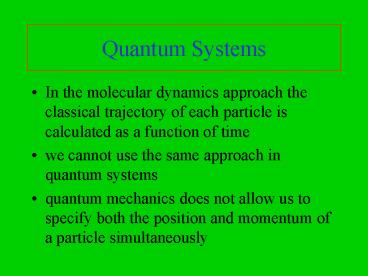Quantum Systems - PowerPoint PPT Presentation
Title:
Quantum Systems
Description:
quantum mechanics does not allow us to specify both the position and momentum of ... Quantum Mechanics. Quantum mechanics does allow us to analyze probabilities ... – PowerPoint PPT presentation
Number of Views:30
Avg rating:3.0/5.0
Title: Quantum Systems
1
Quantum Systems
- In the molecular dynamics approach the classical
trajectory of each particle is calculated as a
function of time - we cannot use the same approach in quantum
systems - quantum mechanics does not allow us to specify
both the position and momentum of a particle
simultaneously
2
Quantum Mechanics
- Quantum mechanics does allow us to analyze
probabilities but there are problems
- Recall the 1-d diffusion equation
- a numerical solution requires us to make x and t
discrete variables - we would need about 103 points for each value of
t whereas molecular dynamics only required one
point
3
Quantum methods
- For many degrees of freedom the problem is more
apparent - P(x1,x2,,xN,t) gt need N1000 points
- methods generally limited to a small number of
particles - since the diffusion equation can be formulated as
a random walk, it will be no surprise that
Schrodingers equation can be analyzed in a
similar way.
4
Review of Quantum Theory
- Consider a 1-d non-relativistic quantum system
- the state of the system is characterized by a
wave function ?(x,t) which is the probability
amplitude - probability of finding a particle in the volume
dx centered about x is P(x,t)dx ?(x,t) 2dx - hence ?(x,t) must be normalized such that
5
Quantum Theory
- In the presence of an external potential V(x,t),
the time evolution of ?(x,t) is determined by
the time-dependent Schrodinger equation
- Each physical variable A has a corresponding
operator Aop - the average value of A is
6
Quantum Review
- For example xop x
- pop -i??/?x
- if the potential is independent of t, ?(x,t)
?(x)e-iEt/? - substituting in the Schrodinger equation we
obtain the time-independent equation
7
Quantum Review
- In general there are many eigenfunctions ?n and
corresponding eigenvalues En - hence ?(x,t) ?cn ?n e-iEnt/ ?
- for bound state solutions E lt V the allowed
energies are quantized - ?n(x) must be finite for all x and bounded for
large x so that it can be normalized - numerical solution?
8
Numerical Solution
- Divide the range of x into intervals of width ?x
- denote discrete positions as xs s ?x
- denote ?s ?(xs) and ?s ?(xs)
- if the potential V(x) satisfies V(-x)V(x) then
the solution have definite parity even or odd - choose ?(0)1 and ?(0)0 for even parity
- choose ?(0)0 and ?(0)1 for odd parity
- guess a value for E
- compute ?s1 and ?s1 using the algorithm
9
Algorithm
- iterate ?(x) toward increasing x until ?(x)
diverges - change E and repeat the steps
- bracket the value of E which gives an acceptable
solution by watching for divergences in opposite
directions
10
Square Well Potential
- V(x) 0 for x lt a V0 for x gt
a - need to input V0, a, parity, initial guess for E
, step size ?x and xmax the maximum value of x - try V0150, a1, ?x .01, xmax 4
eigen
11
Time-dependentSchrodinger Equation
- Numerical solution of the time-independent
equation is straightforward - constant energy solutions do not require us to
make time discrete - how would we solve the time-dependent equation?
- Naïve approach would be to produce a grid in the
x-t plane - tnt0n ?t xsx0s ?x ?(x,t) gt ?(xs,tn)
12
Algorithms
- Need an algorithm that relates ?(xs,tn1) to the
value of ?(xs,tn) for each value of xs - an example is
- This algorithm leads to unstable (divergent)
solutions
13
Algorithms
- A better approach treats the real and imaginary
parts of ? separately - this algorithm ensures that the total probability
remains constant
- The Schrodinger equation becomes (?1)
14
Algorithm
- Numerical solution of these equations is based on
- The probability density is conserved if we use
15
Initial Wavefunction
- Consider a Gaussian wave packet
- The expectation value of the initial velocity is
ltvgtp0/m ?k0/m - in the simulation set m ?1
tdse































